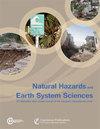Total water levels along the South Atlantic Bight during three along-shelf propagating tropical cyclones: relative contributions of storm surge and wave runup
IF 4.7
2区 地球科学
Q1 GEOSCIENCES, MULTIDISCIPLINARY
引用次数: 5
Abstract
Abstract. Total water levels (TWLs), including the contribution of wind waves, associated with tropical cyclones (TCs) are among the most damaging hazards faced by coastal communities. TC-induced economic losses are expected to increase because of stronger TC intensity, sea level rise, and increased populations along the coasts. TC intensity, translation speed, and distance to the coast affect the magnitude and duration of increased TWLs and wind waves. Under climate change, the proportion of high-intensity TCs is projected to increase globally, whereas the variation pattern of TC translation speed also depends on the ocean basin and latitude. There is an urgent need to improve our understanding of the linkages between TC characteristics and TWL components. In the past few years, hurricanes Matthew (2016), Dorian (2019), and Isaias (2020) propagated over the South Atlantic Bight (SAB) with similar paths but resulted in different coastal impacts. We combined in situ observations and numerical simulations with the Coupled Ocean–Atmosphere–Wave–Sediment Transport (COAWST) modeling system to analyze the extreme TWLs under the three TCs. Model verification showed that the TWL components were well reproduced by the present model setup. Our results showed that the peak storm surge and the peak wave runup depended mainly on the TC intensity, the distance to the TC eye, and the TC heading direction. A decrease in TC translation speed primarily led to longer exceedance durations of TWLs, which may result in more severe economic losses. Wave-dependent water level components (i.e., wave setup and wave swash) were found to dominate the peak TWL within the near-TC field. Our results also showed that in specific conditions, the prestorm wave runup associated with the TC-induced swell may lead to TWLs higher than at the peak of the storm. This was the case along the SAB during Hurricane Isaias. Isaias's fast TC translation speed and the fact that its swell was not blocked by any islands were the main factors contributing to these peak TWLs ahead of the storm peak.三个沿岸传播的热带气旋期间南大西洋海湾的总水位:风暴潮和海浪上升的相对作用
摘要与热带气旋(TC)相关的总水位(TWL),包括风浪的影响,是沿海社区面临的最具破坏性的灾害之一。由于热带气旋强度增强、海平面上升和沿岸人口增加,预计热带气旋造成的经济损失将会增加。热带气旋强度、平移速度和与海岸的距离会影响 TWL 和风浪增加的幅度和持续时间。在气候变化的情况下,预计全球高强度热带气旋的比例将增加,而热带气旋平移速度的变化规律也取决于海盆和纬度。我们迫切需要进一步了解热气旋特征与 TWL 成分之间的联系。在过去几年中,飓风马修(2016 年)、多里安(2019 年)和伊萨亚斯(2020 年)在南大西洋湾(SAB)上空传播的路径相似,但造成的沿岸影响不同。我们将现场观测和数值模拟与海洋-大气-波浪-沉积物传输耦合(COAWST)建模系统相结合,分析了这三个热带风暴下的极端 TWL。模式验证表明,目前的模式设置很好地再现了 TWL 的各组成部分。结果表明,风暴潮峰值和浪高峰值主要取决于热带气旋强度、到热带气旋眼的距离以及热带气旋的方向。热气旋平移速度的降低主要导致 TWL 的超标持续时间延长,从而可能导致更严重的经济损失。研究发现,与波浪有关的水位成分(即波浪起伏和波浪冲刷)主导了近热带气旋场内的 TWL 峰值。我们的研究结果还表明,在特定条件下,与热带气旋引起的涌浪相关的风暴前波浪上升可能会导致 TWL 高于风暴峰值。伊萨亚斯飓风期间沿 SAB 的情况就是如此。伊萨亚斯飓风的热带气旋平移速度快,而且其涌浪没有受到任何岛屿的阻挡,这些都是导致在风暴峰值之前出现最大 TWL 的主要因素。
本文章由计算机程序翻译,如有差异,请以英文原文为准。
求助全文
约1分钟内获得全文
求助全文
来源期刊
CiteScore
7.60
自引率
6.50%
发文量
192
审稿时长
3.8 months
期刊介绍:
Natural Hazards and Earth System Sciences (NHESS) is an interdisciplinary and international journal dedicated to the public discussion and open-access publication of high-quality studies and original research on natural hazards and their consequences. Embracing a holistic Earth system science approach, NHESS serves a wide and diverse community of research scientists, practitioners, and decision makers concerned with detection of natural hazards, monitoring and modelling, vulnerability and risk assessment, and the design and implementation of mitigation and adaptation strategies, including economical, societal, and educational aspects.

 求助内容:
求助内容: 应助结果提醒方式:
应助结果提醒方式:


